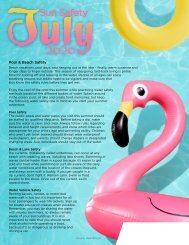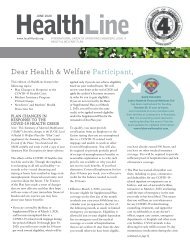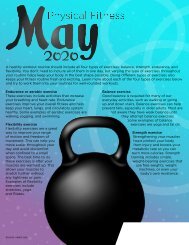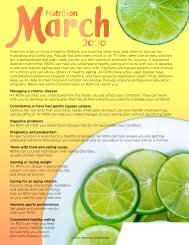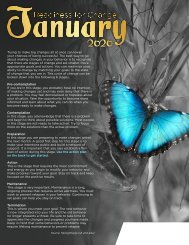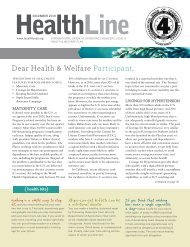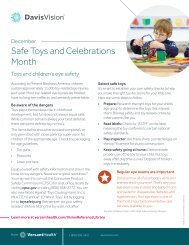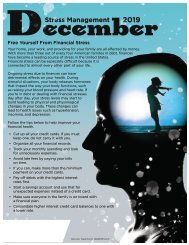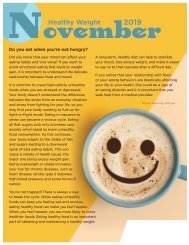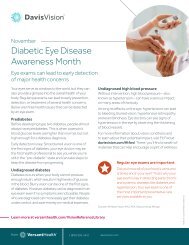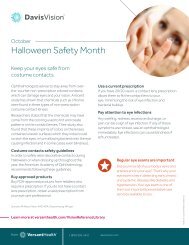Feb 2020
You also want an ePaper? Increase the reach of your titles
YUMPU automatically turns print PDFs into web optimized ePapers that Google loves.
HealthLine<br />
FEBRUARY <strong>2020</strong><br />
www.local4funds.org<br />
INTERNATIONAL UNION OF OPERATING ENGINEERS LOCAL 4<br />
HEALTH & WELFARE PLAN<br />
Dear Health & Welfare Participant,<br />
This edition of HealthLine features the<br />
following topics:<br />
• Report of Contributions<br />
• Updates to Dental Blue Total Health<br />
Solution<br />
• Hinge Health Expands with Hip Program<br />
• Modern Assistance Programs Virtual<br />
Counseling Program<br />
REPORT OF CONTRIBUTIONS<br />
During the month of <strong>Feb</strong>ruary, you<br />
will receive a Report of Contributions.<br />
Your report will contain information<br />
regarding hours you worked and the<br />
contributions made to the Funds on<br />
your behalf by your employer(s) as of<br />
December 31, 2019. You should review<br />
the report for errors and missing hours. If<br />
you need to report missing hours, please<br />
follow the instructions on the Report of<br />
Contributions. All missing or incorrectly<br />
reported hours/contributions must be<br />
provided to the Funds Office in writing.<br />
The Report of Contributions will<br />
include your Health Plan eligibility status. If<br />
you are eligible for Health Plan coverage as<br />
of March 1, <strong>2020</strong>, this information will be<br />
indicated on your report.<br />
Important note about the hours<br />
requirement for coverage under the<br />
Basic Plan: The Health Plan Year runs<br />
March 1, <strong>2020</strong>, through <strong>Feb</strong>ruary 28, 2021.<br />
If you work the required number of hours<br />
(Local 4 = 1,000 hours; Local 4D = 1,500<br />
hours; non-collectively bargained employee<br />
covered under a Participation Agreement =<br />
1,800 hours), you will be covered under the<br />
Basic Plan as of March 1, <strong>2020</strong>.<br />
If your Health Plan coverage will<br />
terminate as of <strong>Feb</strong>ruary 29, <strong>2020</strong>, this will<br />
also be indicated on your report. If your<br />
coverage will be terminating, you will receive<br />
a COBRA information package, which will<br />
also include the Plan A Buy-In information.<br />
Please also keep in mind that you can always<br />
check your hours and your eligibility status<br />
by logging on to the Local 4 Funds’ Member<br />
Self-Service Portal, available on the Funds’<br />
website at www.local4funds.org.<br />
If you have any questions about<br />
enrolling in COBRA or Plan A, please<br />
contact the Health Fund’s Eligibility<br />
Department at 1-508-533-1400, option 5.<br />
UPDATES TO DENTAL BLUE<br />
TOTAL HEALTH SOLUTION<br />
Your Dental Blue benefit has expanded<br />
the list of chronic conditions that qualify<br />
members for Enhanced Dental Benefits.<br />
The updated list now includes stroke<br />
and Sjogren’s syndrome. Members with<br />
qualifying conditions who have both<br />
Condition<br />
Diabetes<br />
One cleaning or<br />
periodontal<br />
maintenance<br />
visit every 3<br />
months<br />
Periodontal<br />
scaling once<br />
per quadrant<br />
every 24<br />
months<br />
✓ ✓<br />
Coronary artery<br />
disease ✓ ✓<br />
Stroke*<br />
medical and dental coverage through<br />
the Plan are automatically enrolled in<br />
this program at Blue Cross Blue Shield<br />
of Massachusetts (BCBSMA). With this<br />
update, qualifying conditions now include:<br />
• Diabetes<br />
• Coronary artery disease<br />
• Stroke<br />
• Pregnancy<br />
• Oral cancer<br />
• Sjogren’s syndrome<br />
The Enhanced Dental Benefits offer<br />
qualifying members additional, specific<br />
support, including full coverage for<br />
preventive and periodontal services<br />
that have been connected to improved<br />
overall health. Please see the table below<br />
for coverage details for members with<br />
qualifying conditions.<br />
Oral cancer<br />
screening<br />
once<br />
every 6<br />
months<br />
Fluoride<br />
treatment<br />
every 3<br />
months<br />
✓ ✓<br />
Pregnancy<br />
✓ ✓<br />
Oral cancer<br />
✓ ✓ ✓<br />
Sjogren’s<br />
syndrome* ✓ ✓ ✓<br />
*Stroke and Sjogren’s syndrome are conditions being added to benefits effective September 1, 2019.<br />
(continued on page 8)
2<br />
WANNA LOSE WEIGHT?<br />
Forgo Fad Diets<br />
(recipe)<br />
Slow-Cooker Chicken<br />
Lentil Casserole<br />
Cooking oil spray<br />
¾ lb. boneless, skinless chicken breast<br />
(about 1 large)<br />
1 small onion, diced (about 1 cup)<br />
6 oz. portabella mushrooms, diced<br />
1 lb. frozen spinach, thawed<br />
1 cup dry lentils, rinsed in cold water to clean<br />
1 jar mango chutney (9 oz.)<br />
1 tbsp. fresh thyme, minced, plus<br />
more for garnish<br />
1 quart no- or low-salt chicken stock<br />
1½ cups water<br />
½ tsp. black pepper<br />
1 cup brown rice<br />
VISITING THE DIET SECTION AT THE<br />
BOOKSTORE could make you believe that<br />
there are countless tricks to lose weight.<br />
But experts say there is only one proven<br />
way to lighten the load—by burning more<br />
calories than you eat and drink. Several<br />
fad diets ignore this rule and just don’t<br />
work. And some diets can threaten your<br />
short- and long-term health.<br />
Consider these ways to lose weight<br />
safely:<br />
Eat a variety of foods to get all<br />
your daily nutrients. Focus on<br />
fruits, vegetables, whole grains,<br />
lean meats, poultry, fish, and<br />
fat-free or low-fat dairy.<br />
Limit saturated fat intake<br />
to less than 10 percent of<br />
your daily calories.<br />
Decrease the amount of<br />
sugar, cholesterol, and salt<br />
in your diet.<br />
Avoid soda and alcohol.<br />
Drink water instead.<br />
Read nutrition labels and<br />
follow the recommended<br />
serving size.<br />
Get 30 to 60 minutes of<br />
exercise, four to six times<br />
per week. Walking and cycling<br />
are good bets.<br />
Talk with your health care provider<br />
if you want to lose weight. He or she<br />
can help you find a weight-loss plan<br />
that’s safe, effective, and tailored to<br />
your specific needs.<br />
Heat a large nonstick or cast-iron pan over<br />
high heat for one minute. Spray with oil, heat<br />
for 30 more seconds, then add chicken breast.<br />
Sauté until both sides are browned but not<br />
cooked through all the way, about five minutes.<br />
Place chicken and all ingredients, except<br />
for brown rice, into slow cooker. Cook on high<br />
for 2½ hours or on low for 6 hours. Add rice<br />
and cook on high for 1½ more hours. If chicken<br />
breast hasn’t fallen apart, use a fork and knife<br />
to shred and mix it in casserole. Garnish with<br />
fresh thyme if so desired.<br />
Serves 10; serving size is 2 cups.<br />
Each serving provides about 234 calories,<br />
1 g total fat (0.3 g saturated fat, 0 g trans fat),<br />
20 mg cholesterol, 230 mg sodium,<br />
40 g carbohydrates, 8 g fiber, 11 g sugar,<br />
and 17 g protein.
3<br />
ALMONDS CAN’T BE MILKED (DUH!). COCONUTS DON’T HAVE UDDERS (THANK GOODNESS!).<br />
NEVERTHELESS, PLANT-BASED “MILKS” ARE TAKING OVER DAIRY SECTIONS IN GROCERY STORES AROUND<br />
THE COUNTRY. WHETHER YOU’RE CONSIDERING GOING NONDAIRY FOR GOOD, OR JUST CURIOUS ABOUT<br />
ADDING A SPLASH OF SOY MILK TO YOUR MORNING COFFEE, HERE’S WHAT YOU SHOULD KNOW.<br />
COW-NTERFEITS<br />
Plant milk isn’t real milk. Instead<br />
of coming from a cow, it’s processed<br />
from plants such as nuts, coconuts,<br />
seeds, and grains. Almond milk, for<br />
example, is made by soaking and<br />
grinding almonds and then mixing<br />
the paste with water.<br />
There’s talk about possibly<br />
removing “milk,” “yogurt,” and<br />
“cheese” from the labels of plant-based<br />
products. The U.S. Food and Drug<br />
Administration worries that consumers<br />
may misinterpret these terms to mean<br />
that plant alternatives have the same<br />
nutritional qualities as dairy products.<br />
GLASS HALF FULL<br />
Plant-based milk may not have the same<br />
nutrients as cow’s milk, but it still offers<br />
several benefits. For starters, many<br />
varieties contain health-promoting<br />
compounds. What’s more, plant milk<br />
serves as a nondairy substitute for those<br />
who are lactose intolerant or allergic to<br />
milk. It also fits the vegan lifestyle. And<br />
even if you don’t need to take milk<br />
products out of your diet, plant-based<br />
milk can be a fun change in taste<br />
and texture.<br />
NOT ALL MILKS ARE CREATED EQUAL<br />
When it comes to choosing the plant milk for you, consider the pros and cons of these<br />
four popular varieties:<br />
Contains<br />
vitamin E,<br />
potassium,<br />
magnesium<br />
Low in<br />
protein<br />
Contains<br />
antioxidants<br />
High in<br />
saturated fat<br />
Opt for “fortified” versions to get as many<br />
nutrients as possible. But keep in mind that you<br />
still may not be getting all the calcium, protein,<br />
and vitamin D that comes with dairy. That’s why<br />
it’s important to meet with a dietitian and learn<br />
how to incorporate plant-based milk into a<br />
healthy, balanced diet for you and your family.<br />
Contains<br />
beta-glucan<br />
(may help lower<br />
blood sugar<br />
and cholesterol<br />
levels)<br />
Low in<br />
calcium<br />
DO YOU KNOW<br />
YOUR DAIRY?<br />
Test your knowledge<br />
by taking a quiz. Visit<br />
Good source<br />
of protein<br />
(closest to<br />
cow’s milk)<br />
Low in<br />
calcium<br />
www.choosemyplate.gov/quiz.
4<br />
2 SCREENS AREN'T BETTER THAN 1:<br />
THE DANGERS OF MEDIA MULTITASKING<br />
CHANCES ARE YOU’RE GUILTY OF<br />
WATCHING TV WHILE USING<br />
ANOTHER DEVICE. This is called second<br />
screening or media multitasking, and an<br />
estimated 87 percent of people do it. But<br />
digital distraction isn’t always good for<br />
bodies and brains.<br />
THE TROUBLE WITH JUGGLING<br />
Our neural networks weren’t designed<br />
for the constant barrage of information.<br />
Some studies show that heavy<br />
multitaskers:<br />
• Are forgetful and have trouble<br />
paying attention<br />
• Behave more impulsively<br />
• Risk social anxiety and depression<br />
• Are more often obese<br />
• Have less gray matter in areas of<br />
the brain linked to control of<br />
thoughts and emotions<br />
The impact may be more significant on<br />
kids’ and teens’ developing brains.<br />
SCREEN TIME SAVVY<br />
Need to cut back on your screen time?<br />
Here are some tips to start:<br />
• Try a digital detox. Go a week—<br />
if you can—phone-free. Notice<br />
how you feel. Then aim to build in<br />
more low-tech periods throughout<br />
your day.<br />
• Shut off alerts. Disable notifications on<br />
apps. Constant pings may negatively<br />
affect your well-being.<br />
• Make household rules. Declare some<br />
spaces and times—say, dinner and<br />
bedrooms—device-free. By engaging<br />
in screen-free family activities, you’ll<br />
model healthy technology use for<br />
your children.<br />
(test your savvy on … antibiotics)<br />
1. Antibiotics are a cure-all for what ails you.<br />
■ TRUE ■ FALSE<br />
2. Antibiotics work by fighting bacteria that make you<br />
sick, either by killing them or stopping them from<br />
growing. ■ TRUE<br />
■ FALSE<br />
3. If your doctor prescribes an antibiotic, take all the<br />
medication prescribed. ■ TRUE ■ FALSE<br />
4. Don’t take an antibiotic unless your doctor says you<br />
need it. ■ TRUE ■ FALSE<br />
stronger bacteria that are harder to treat.<br />
4. True. If antibiotics are taken when they aren’t needed, they can create<br />
only part of the infection.<br />
3. True. If you use only part of the medicine, it can mean you treated<br />
more often antibiotics are used, the bigger the risk that this can happen.<br />
2. True. But sometimes, bacteria learn how to resist an antibiotic. The<br />
Antibiotics won’t help you fight these illnesses.<br />
a big help. But most common colds and flu are caused by viruses.<br />
1. False. If you have a bacterial infection—like pneumonia—they can be<br />
ANSWERS
5<br />
Keep Kids Healthy with Vaccines<br />
Why Vaccinate?<br />
VACCINES CAN HELP YOUR CHILDREN GROW UP HEALTHY<br />
BY PROTECTING THEM FROM SERIOUS DISEASES.<br />
Vaccines have<br />
reduced or even<br />
eliminated many<br />
diseases in the U.S.—<br />
like polio.<br />
Vaccines protect<br />
your children from<br />
serious diseases and<br />
their complications,<br />
like hearing loss or<br />
paralysis.<br />
Vaccines protect the<br />
people around you—<br />
those with weak<br />
immune systems and<br />
babies who are too<br />
young to be<br />
vaccinated.<br />
As vaccination rates<br />
climb, community<br />
immunity rises—<br />
making it harder for<br />
diseases to spread.<br />
Research has<br />
disproved that<br />
vaccines cause<br />
conditions such as<br />
autism or sudden<br />
infant death<br />
syndrome.<br />
Measles Is on the Rise in the U.S.<br />
Measles<br />
infections are<br />
increasing, most<br />
likely because<br />
of a drop in<br />
vaccination<br />
rates.<br />
Measles spreads<br />
through the air when<br />
an infected person<br />
coughs or sneezes.<br />
Measles is so<br />
contagious that if<br />
one person has it,<br />
up to 90% of the<br />
people close to<br />
that person who<br />
aren’t immune<br />
will also become<br />
infected.<br />
About 1 in 5 people in<br />
the U.S. who gets measles<br />
will be hospitalized.<br />
Getting<br />
vaccinated is<br />
your best<br />
defense against<br />
measles.<br />
By age 2, your child should receive protection against 14 vaccine-preventable diseases.<br />
Visit www.cdc.gov/vaccines/schedules to view the recommended immunization schedule.
6<br />
NO GYM?<br />
NO PROBLEM<br />
YOUR COMPLETE<br />
DIY WORKOUT<br />
Sure, you can dead lift with dumbbells, hoist heavy metal plates on<br />
weight machines, or reach for resistance bands. But there’s another<br />
way to build strong muscles, healthy bones, and the power to<br />
bound up stairs or carry armloads of groceries.<br />
You can get an effective, fun, and safe strengthening workout using<br />
equipment you carry with you every day: the weight of your own body.<br />
TIME TO GET MOVING<br />
The U.S. Department of Health and Human Services recommends adults<br />
perform two muscle-strengthening sessions per week, in addition to at<br />
least 150 minutes of moderate-intensity aerobic movement.<br />
Your bodyweight workouts should involve all the major muscle<br />
groups: legs, hips, back, abs, chest, shoulders, and arms. Here are<br />
a few types of exercises you can include. Pick which ones you want<br />
to do and create your own workout!<br />
SUPERMAN<br />
Lie on your stomach with your legs<br />
extended behind you and your arms<br />
stretched in front of you. Exhale, tighten<br />
your abs and core muscles, then raise<br />
your arms and legs a few inches<br />
off the ground. Hold briefly,<br />
then inhale and<br />
slowly lower.<br />
WALL PUSH-UPS<br />
Start standing, a little more than<br />
arm’s-length distance from a wall, with<br />
your feet shoulder-width apart. Lean<br />
forward and place your palms flat on the<br />
wall. Lower your upper body toward the<br />
wall by slowly bending your elbows.<br />
Hold for one second, then<br />
straighten your arms to<br />
return to the start.<br />
BODYWEIGHT SQUAT<br />
Stand with your feet slightly<br />
wider than hip-width and<br />
your weight in your heels.<br />
Inhale, push your hips back,<br />
and lower yourself down toward the<br />
ground until your thighs are parallel to<br />
the floor or until your heels lift off the<br />
ground, whichever comes first. Exhale<br />
and return to standing.<br />
BRIDGE<br />
Lie on your back, knees bent, feet flat on<br />
the floor. Tighten your abs, exhale, and<br />
squeeze your butt muscles to lift your hips<br />
up off the ground. Inhale and slowly lower.<br />
CHAIR DIP<br />
Choose a sturdy chair with<br />
armrests and sit with your<br />
feet flat on the floor. Inhale,<br />
lean forward, and grasp the<br />
arms of the chair. Exhale and<br />
use your arms to push<br />
upward and out of the chair.<br />
Hold for about one second,<br />
then inhale and slowly lower.<br />
Other standard bodyweight moves include LUNGES, PLANKS, HEEL RAISES, JUMPING JACKS, AND PULL-UPS.<br />
If you have a chronic health condition or haven’t had a checkup in a while, talk with your<br />
health care provider before starting a new exercise program.
77<br />
Brush<br />
FOR BETTER BRAIN HEALTH<br />
GOOD ORAL HEALTH NOT ONLY<br />
KEEPS YOUR BREATH MINTY FRESH<br />
AND YOUR TEETH PEARLY WHITE, but<br />
also helps protect your brain—specifically,<br />
your memories. According to recent<br />
research, there’s a relationship between<br />
gum disease and your chances of<br />
developing Alzheimer’s disease.<br />
WHAT THE SCIENCE SAYS<br />
Porphyromonas gingivalis (a fancy name<br />
for a specific type of bacteria) is the main<br />
culprit responsible for gum disease.<br />
However, it can affect more than just<br />
your mouth. Scientists also find this<br />
bacteria in the brains of people with<br />
Alzheimer’s—suggesting that it may<br />
contribute to the disease’s development.<br />
Other research further solidifies this<br />
connection. In one study, researchers<br />
analyzed patients diagnosed with<br />
chronic periodontitis (CP)—a type of<br />
gum disease—and compared them with<br />
patients without CP. The results showed<br />
that after 10 years, those with CP had<br />
more than one-and-a-half times the risk<br />
for Alzheimer’s disease.<br />
TO BRUSH, OR NOT TO BRUSH?<br />
It can be easy to justify skipping oral care<br />
at the end of the day. After all, your<br />
pillow is oh-so comfy and your bathroom<br />
is oh-so far away! But no matter how old<br />
you are—or how tired—brushing and<br />
flossing need to be at the top of your<br />
to-do list. After all, poor brushing and<br />
flossing habits let plaque build up on<br />
your teeth and can lead to gum disease.<br />
Symptoms of gum disease include:<br />
• Tender, swollen, or bleeding gums<br />
• Loose teeth<br />
• Painful chewing<br />
If you experience any of these symptoms,<br />
be sure to tell your dentist. He or she can<br />
check if you have gum disease and<br />
recommend treatment.<br />
TAKING CARE OF YOUR TEETH<br />
When it comes to your health, brushing<br />
is a no-brainer (and a brain-helper!).<br />
Follow these tips to promote a lifetime of<br />
beautiful smiles and lasting memories:<br />
• Using a fluoride toothpaste, brush<br />
your teeth twice a day.<br />
• Floss once a day. Rinse your mouth<br />
with water after you floss.<br />
• Visit your dentist once or twice a year<br />
for a checkup and cleaning.<br />
• Avoid sugary foods, sweetened drinks,<br />
and tobacco.<br />
Want to ward off depression as<br />
you get older? Make sure to stay<br />
fit through midlife, says a new<br />
study in JAMA Psychiatry. A high<br />
level of cardiovascular<br />
fitness in middle age<br />
was associated with a<br />
lower risk for<br />
depression later in<br />
life and a lower<br />
risk of dying of<br />
cardiovascular<br />
disease.<br />
(health bits)
IUOE Local 4 Health & Welfare Plan<br />
PO Box 660<br />
Medway, MA 02053-0660<br />
PRSRT STD<br />
U.S. POSTAGE<br />
PAID<br />
LONG PRAIRIE, MN<br />
PERMIT NO. 372<br />
www.local4funds.org<br />
6272M<br />
(health bits)<br />
Screening tests for breast<br />
and cervical cancer save<br />
women’s lives. That’s why the<br />
National Breast and Cervical Cancer<br />
Early Detection Program offers free or<br />
low-cost screenings at sites across the<br />
country. Go to www.cdc.gov/cancer/<br />
nbccedp/index.htm to find out if you<br />
qualify and to find a local provider.<br />
Did you know that a flu shot<br />
protects you from multiple<br />
strains of the virus? Every year,<br />
researchers update the vaccine to<br />
match the types of flu you are most<br />
likely to encounter. That’s why the<br />
Centers for Disease Control and<br />
Prevention recommends that everyone<br />
6 months and older receive an annual<br />
flu shot.<br />
In the U.S., nearly one in<br />
four households includes<br />
someone who suffers from<br />
migraines—extreme headaches that<br />
can come with nausea, vomiting,<br />
dizziness, and sensitivity to sound,<br />
light, touch, and smell. The cause of<br />
migraines is not well understood, but<br />
food may play a role in triggering<br />
them for some people. Want to head<br />
off a headache? Try substitutions for<br />
common food triggers. For example,<br />
drink water or white milk instead<br />
of soda.<br />
(continued from page 1)<br />
Enhanced Dental Benefits are fully covered<br />
and are not subject to a deductible, co-insurance,<br />
or calendar-year maximum when a member<br />
visits a participating in-network dentist.<br />
Go to member.bluecrossma.com/fad<br />
to find a participating dental provider.<br />
Please call Member Services at BCBSMA<br />
with any questions on your dental benefits<br />
at 1-800-401-7690.<br />
HINGE HEALTH EXPANDS<br />
WITH HIP PROGRAM<br />
Eligible participants and dependents enrolled in<br />
the Health & Welfare Plan not only have free<br />
access to Hinge Health’s innovative 12-week<br />
digital programs for back or knee pain, but also<br />
to Hinge’s new chronic hip pain program.<br />
The Hip Pain Care Pathway is a free<br />
12-week digital program that allows members<br />
to participate when it fits their schedules.<br />
What do members receive once enrolled? A<br />
free tablet and wearable sensors; personalized<br />
exercise therapy; and unlimited one-on-one<br />
health coaching. Members who qualify for the<br />
hip program and have already taken advantage<br />
of the back or knee program will not receive an<br />
additional tablet but will access the program on<br />
the original tablet sent by Hinge.<br />
Just like the back and knee pain programs,<br />
Hinge will empower members to improve<br />
habits and learn effective tips to reduce hip<br />
pain, all from the comfort of home.<br />
To learn more, or to apply for any<br />
of Hinge’s innovative programs, visit<br />
www.hingehealth.com/local4. Please feel<br />
free to contact the Funds Office at 1-508-<br />
533-1400, option 5, with any questions.<br />
MODERN ASSISTANCE<br />
PROGRAMS VIRTUAL<br />
COUNSELING PROGRAM<br />
Modern Assistance Programs, Inc. (MAP) is<br />
pleased to announce an added benefit to eligible<br />
SAVE THE DATE<br />
Labor Health & Financial<br />
Wellness Fair<br />
Sunday, March 22, 11 a.m. to 4 p.m.<br />
Join hundreds of union members<br />
and their families at Lombardo’s<br />
in Randolph, MA, for an exciting<br />
event catered to working<br />
families like yours!<br />
members and dependents: virtual counseling.<br />
With this program, members will have<br />
easy access to therapy that is user-friendly,<br />
HIPAA-compliant, and confidential.<br />
Virtual counseling eliminates travel time<br />
and allows members to communicate with a<br />
counselor by simply using an email address<br />
and a camera-enabled device. For more<br />
information on how the program works,<br />
please call MAP at 1-800-878-2004.<br />
Sincerely,<br />
Your Board of Trustees<br />
William D. McLaughlin, Chairman<br />
Angelo Colasante<br />
Paul C. DiMinico<br />
David F. Fantini<br />
David B. Marr, Jr.<br />
James Reger<br />
IUOE Local 4<br />
William D. McLaughlin, Business Manager<br />
Administrator<br />
Gina M. Alongi<br />
Information in the publication is the opinion of the authors. Personal decisions regarding health, finance, exercise, and other matters should be made after<br />
consultation with the reader’s professional advisors. All models used for illustrative purposes only. All editorial rights reserved. Developed by StayWell.



